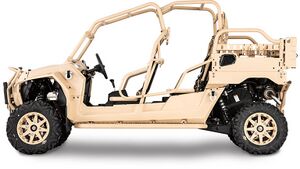Venator VAULT
This article is incomplete because it is pending further input from participants, or it is a work-in-progress by one author. Please comment on this article's talk page to share your input, comments and questions. Note: To contribute to this article, you may need to seek help from the author(s) of this page. |
VAULT, or Venture Advanced Ultra-Light Tactical is a series of all-wheel drive light military vehicles produced by Venator Defence. Since the creation of VAULT in 2011 they have become a major supplier of light vehicles for the Belfrasian Armed Forces and a number of foreign buyers.
History
VAULT's life technically started in 2000, with the development team of VAULT today being directly responsible for the creation of Belfrasian Military Solutions' Weasel Armoured Fighting Vehicle. The Weasel is a light, agile vehicle capable of withstanding enemy fire whilst conducting fast reconnaissance missions behind enemy lines within the tactical arena. The heavy armour cladding seen on the Weasel by standard today started as an add-on package, with the base model being light-weight and highly agile. The development team of the Weasel were eventually laid off by BMS as a result of budget cuts in 2009, causing them to found Venator Defence. Due to multiple developers of the new organisation having ties with the Belfrasian Army they received a request for ultra-light weight vehicles for service with existing air mobility platforms. The first concept, the Ferret, was accepted in 2013 to augment light infantry roles as applicable. The Ferret is highly agile and light weight, capable of being carried in medium-lift aircraft and even taken apart with relative ease.
Ferret Utility Task Vehicle
Design
The Ferret was the first vehicle designed in the VAULT series and was done so at special request of the Belfrasian Army, which requested for a 'light vehicle capable of being deployed by a large variety of air mobile platforms for usage with light infantry or special forces.'
Variants
Operators
-
- Airmobile Brigade Groups
- 904 Marine Commando Battalion, 1 MBG
Polecat Combat Vehicle
Design
The Polecat is an ultra-light combat vehicle designed to provide light infantry and special operations forces a light mobility system capable of tackling tough off-road terrain. It is capable of being transported internally by a majority of cargo helicopters, slung-load with the usage of sling-points on the vehicle, or airdropped without risk.
The engine of the Polecat is capable of running in the 'normal' operational configuration, which utilises the on-board fuel in normal operations, an 'high-rev' mode which provides additional horsepower and traction for steep incline driving at the cost of fuel, and an economic mode that conserves fuel at the cost of horsepower but with the benefit of being the quietest of the modes. Despite the economic mode's stated level of quietness, the engine itself is remarkably silent during even high-rev driving as to not give away the crew's positions when driving in hostile territory. The special design of the vehicle and usage of off-the-shelf technology has resulted in the vehicle having a range of 500 miles, which is only mildly affected when full laden with cargo, ordnance, and personnel.
The installation of pintle mounts at all the seats, including the driver, and the top-mounted weapons station allow for a wide variety of weapon options for the vehicle. The top-mounted station is capable of holding heavy weapon mounts such as a 12.7mm heavy machine-gun or an anti-tank/anti-air missile launcher. The payload area at the back can be modified on the fly and can hold up to 1,474 kg of cargo or be refitted to hold seats for four individuals to bring the total crew limit to nine (including the four seats up front and drop-down seat for the gunner.) The high mobility in rough terrain and the wide variety of options available made it an easy choice for the special forces in conducting their missions.
Variations on the vehicle design tend to be made per mission, however certain kinds require more heavy machinery and take time and most modifications tend to focus on the rear cargo area of the vehicle. All variants feature a hidden from winch capable of pulling 1,200 kg of cargo and a rear tow capability to pull a trailer or an unladen Polecat for recovery purposes.
Variants
- Polecat Patrol
- Standard variant, contains four seats with a fifth deployable rest for the gunner. Back of the vehicle is modifiable on the fly with either 1,474 kg of cargo capacity, seating for four, or a hybrid mixture.
- Polecat Rapid Fire Support
- Better known as the 'RFS' variant, it removes the rear seating for a heavy weapons mount, typically a heavy mortar along with ammunition container cells for the weapon installed.
- Polecat Medical
- Maintains the two-seater variant of the RFS but has rack capacity for two litters. Racks holding the litters sits above storage units for medical kits and have net protectors to keep patients from falling out of their litter when mobile.
Operators
See Also
- Venator ADAMANT - Advanced Modular Multi-Mission Tactical Vehicles made by Venator Defence.

